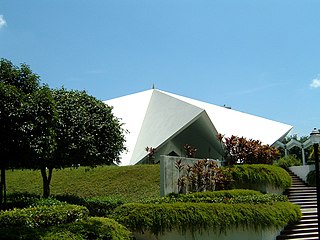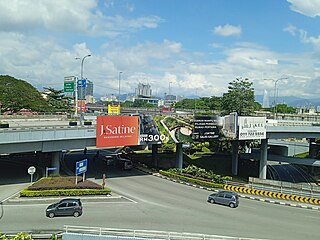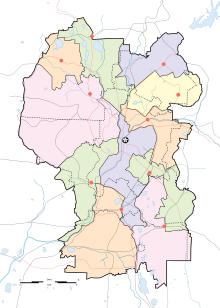
Tun Haji Abdul Razak bin Dato' Haji Hussein was a Malaysian lawyer and politician who served as the second prime minister of Malaysia from 1970 until his death in 1976. He also served as the first deputy prime minister of Malaysia from 1957 to 1970. He is referred to as the Father of Development.

Tunku Abdul Rahman Putra Al-Haj ibni Almarhum Sultan Abdul Hamid Halim Shah was a Malaysian statesman and lawyer who served as the first prime minister of Malaysia and the head of government of its predecessor states from 1955 to 1970. He was the first chief minister of the Federation of Malaya from 1955 to 1957. He supervised the independence process that culminated on 31 August 1957. As an independent Malaysia's first prime minister, he dominated the country's politics for the next 13 years.

Tun Hussein bin Dato' Onn was a Malaysian lawyer and politician who served as the third Prime Minister of Malaysia from the death of his predecessor Abdul Razak Hussein in 1976 to his retirement in 1981. Moreover, he was the Member of Parliament (MP) for Sri Gading from 1974 to 1981, representing Barisan Nasional (BN) and United Malays National Organisation (UMNO). He was granted the soubriquet Father of Unity.

The Sultan Abdul Samad Building is a late-19th century building located along Jalan Raja in front of Dataran Merdeka and the Royal Selangor Club in Kuala Lumpur, Malaysia. The building originally housed the offices of the British colonial administration, and was known simply as Government Offices in its early years. In 1974, it was renamed after Sultan Abdul Samad, the reigning sultan of Selangor at the time when construction began.

The National Mosque of Malaysia is a mosque in Kuala Lumpur, Malaysia. It has a capacity for 15,000 people and is situated among 13 acres (53,000 m2) of gardens. Its key features are a 73-metre-high (240 ft) minaret and a 16-pointed star concrete main roof. The umbrella, synonymous with the tropics, is featured conspicuously – the main roof is reminiscent of an open umbrella, the minaret's cap a folded one. The folded plates of the concrete main roof are a creative solution to achieving the larger spans required in the main gathering hall. Reflecting pools and fountains are spread throughout the compound. Completed in 1965, the mosque is a bold and modern approach in reinforced concrete, symbolic of the aspirations of a then newly independent nation.

Tun Abdul Ghafar bin Baba was a Malaysian politician who served as 6th Deputy Prime Minister of Malaysia from 1986 to 1993.

The Ubudiah Mosque is a small mosque located in the royal town of Kuala Kangsar, Perak, Malaysia.

The Federal Territory Mosque is a mosque in Kuala Lumpur, Malaysia. It is located near MATRADE complex and the Federal Government Complex off Jalan Duta, in Segambut district.

This article lists important figures and events in Malaysian public affairs during the year 1973, together with births and deaths of notable Malaysians.

Chow Kit Monorail station is a Malaysian elevated monorail train station that serves as a part of the Kuala Lumpur Monorail, located in Kuala Lumpur and opened alongside the rest of the train service on August 31, 2003.

The Genting Klang–Pahang Highway or officially Jalan Genting Klang and Jalan Pahang, as it is locally known, is a major highway in Kuala Lumpur, Malaysia.
The architecture of Kuala Lumpur is a blend of old colonial influences, Asian traditions, Malay Islamic inspirations, modern and post modern mix. Being a relatively young city, most of Kuala Lumpur's colonial buildings were built toward the end of 19th and early 20th century. These buildings have Mughal, Tudor, Neo-Gothic or Grecian-Spanish style or architecture. Most of the styling have been modified to cater to use local resources and the acclimatized to the local climate, which is hot and humid all year around.
Abd al-Rahman is a masculine Muslim name. Abdur Rahman, Abdur Rehman, Abdr Rahman, Abdul Rahman, Abdul Rehman or variants may also refer to:

Jalan Tun Perak, formerly Jalan Mountbatten (1961–1981) Mountbatten Road (1946–1961) and Java Street (1889–1946), is a major road located in the historic centre of Kuala Lumpur, Malaysia. It was a major commercial street of early Kuala Lumpur, and is now the location of a few financial institutions. The entry to the Jamek Mosque is located here, and the light rapid transit stop on this street is Masjid Jamek LRT station.
Dato' Y. T. Lee, also Lee Yoon Thim was a Malaysian Chinese architect active in Kuala Lumpur in the 1950s and 1960s. He helped "Build Merdeka" after Malaysian Independence, 1963. He moved in elite circles, and held several positions in the national government and in the Chinese community. He was a close friend to Prime Minister Tuanku Abdul Rahman and other political figures. He designed several of Kuala Lumpur's landmark buildings, such as: Chin Woo Stadium, UMNO building, Dewan Bahasa dan Pustaka, Federal Hotel, Kampung Baru Mosque, Ar-Rahman Mosque and the Masjid Al-Ubudiyah. In addition to his famous mosques in Kuala Lumpur, he also worked on middle eastern and Islamic architecture project, for example, Masjid Al- Ubudiyah in Kerling, Hulu Selangor which is opened in 1960. When this masjid is built, there was no electricity supply yet. Somehow now it has been used as a teaching place by the locals. His less well known works include the Too House, an addition for the Methodist Boys School, and healthcare-related and commercial work. In the early 1960s, a series of honours came his way: in 1960, he was granted the appellation of P.J.K.; in 1961, he was honoured as Justice of Peace and J.M.N in 1962; he was honoured as Dato' in 1964, an honorific similar to the British "Sir".

The Al-Rahman Mosque is a mosque in Kuala Lumpur, Malaysia. The mosque is located at University of Malaya in Jalan Pantai Baharu and was named after the first Malaysian Prime Minister, Tunku Abdul Rahman Putra Al-Haj. Today, the mosque is joint managed by University of Malaya and the Department of Federal Territory Islamic Affairs (JAWI).

Jamek Mosque, officially Sultan Abdul Samad Jamek Mosque is one of the oldest mosques in Kuala Lumpur, Malaysia. It is located at the confluence of the Klang and Gombak rivers and may be accessed via Jalan Tun Perak. The mosque was designed by British architect and soldier Arthur Benison Hubback, and built in 1909. It was the principal mosque of Kuala Lumpur until the construction of the national mosque Masjid Negara in 1965.
The following is an alphabetical list of articles related to Selangor.
Kampung Padang Balang or Padang Balang is the oldest surviving traditional village in Kuala Lumpur, Malaysia. It is circumferenced by Gombak Road, Jalan Kampung Bandar Dalam, Duta–Ulu Klang Expressway (DUKE), Kuala Lumpur Middle Ring Road 2 and Gombak River.


















